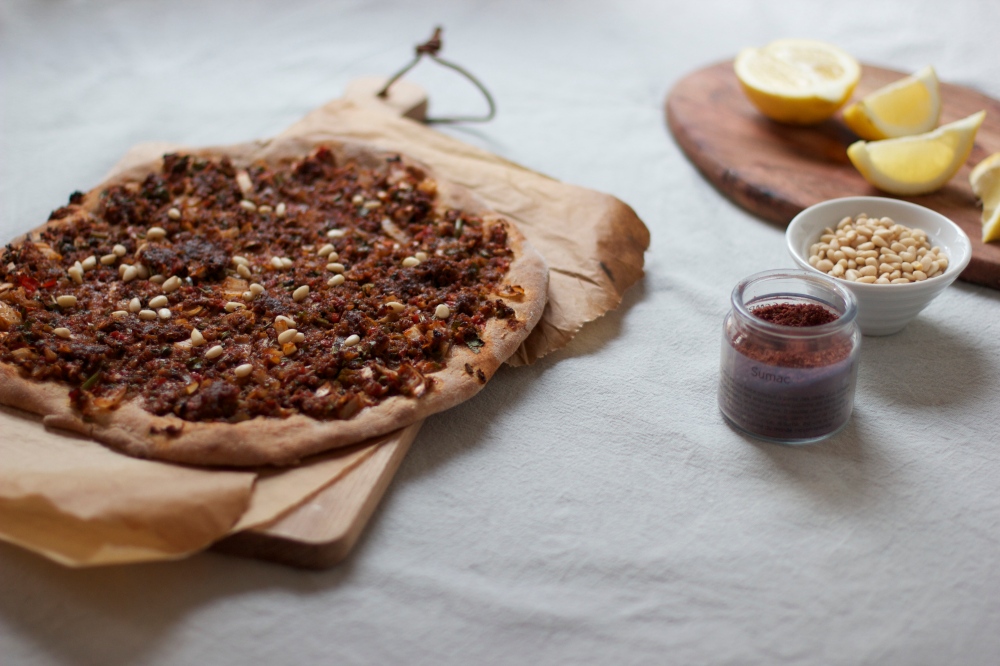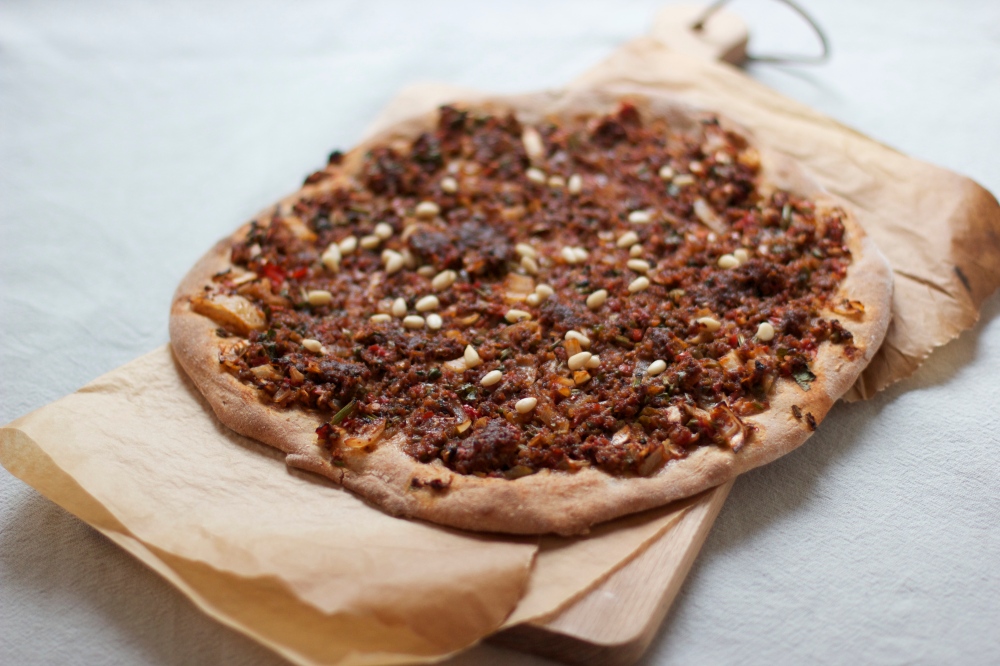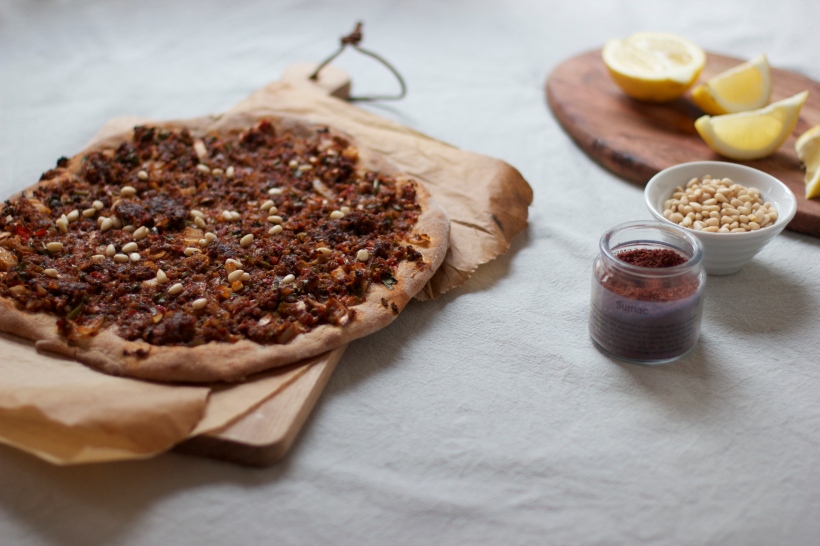
After a couple of months of being far busier than I like and travelling almost every other weekend, I am looking forward to spending a few uninterrupted weeks in Brussels. Regular trips to the farmers market are back on the agenda and it feels good to have the time to cook again and make the most of my ever-expanding cookbook selection. I also finally have the chance to go through my backlog of posts to share here. So let’s talk about Lahmacun, the subject of today’s recipe.
There are two surprising things about living in Germany that I only really appreciated when I moved abroad (17 years ago this summer!): the fact that every neighbourhood has at least one Italian Gelateria and that Lahmacun is easy and cheap to get everywhere.
Lahmacun is often referred to as Turkish Pizza but that is about as accurate a description as calling Flammkuchen Alsatian Pizza. So just think of Lahmacun as it’s own thing: a rather moreish Turkish flatbread topped with minced meat (lamb or beef) to which a mixture of finely chopped onion, green pepper, fresh tomato, parsley and garlic, tomato paste and pomegranate molasses is added and which is seasoned with cinnamon, allspice, cumin, red chili flakes and salt. Once baked in a very hot oven, it is topped with a sprinkle of sumac, fresh lemon juice and pine nuts to serve as a snack or starter. To turn Lahmacun into a full meal, you can top it with sliced cucumber, tomatoes, crumbled feta, some green chilies and garlic yoghurt sauce. This sumac onion salad also sounds like a wonderful idea for a topping.
Lahmacun was my go-to after-school snack as a teenager. It was super cheap even for us students and there was a Turkish Kebap shop within walking distance from my secondary school. It was actually only once I was living in Rome and regularly craving non-Italian food that I learned how to make Lahmacun myself. Which is silly.
If making Lahmacun sounds fussy, it really isn’t. It is no harder than making your own pizza. In fact, it is quicker than making pizza! From start to finish it takes not even 1 hour to make Lahmacun. The dough is prepared in a matter of minutes and while it rests (and the oven pre-heats) you can take care of the topping. And for that you can simply throw all the ingredients into your food processor. And most ingredients you probably already have at home. While I love the addition of pomegranate molasses, I have seen plenty of recipes leaving it out. So if that is the one ingredient you don’t already have, skip it!
One thing people argue over when it comes to making Lahmacun is whether to use yeast for the dough or not. Apparently both are common in Turkey. My Turkish cookbook suggests a simple dough of flour, water, olive oil and salt. But many recipes online recommend a yeasted dough. I have tried both versions and must admit I prefer the non-yeast version as that is closer to what I grew up with in Germany (and when I want a fluffy and chewy flatbread, I might as well make Pizza or Naan). Bonus, no need to wait for the dough to prove! If you have leftover pizza dough, by all means use that (just don’t tell your Turkish friends!). The key is to make sure you roll the dough out as thin as possible.

Lahmacun
Notes: This recipe makes 4 large Lahmacun. Enough to feed four adults. If serving these as part of a larger meal, you could also make smaller Lahmacun. Once cooked, Lahmacun will keep for a couple of days in the fridge and can simply be reheated in the oven. Also, don’t tell your Turkish friends, but I have found cooked brown lentils a decent substitute for the minced meat if you want to try a vegetarian version.
Serves 4
Ingredients
For the Dough
400g flour
2tbsp olive oil
2 tsp salt
280ml warm water
For the Topping
400g minced lamb
2 tomatoes
2 onions
2 Turkish green peppers
2 garlic cloves
2 tbsp tomato paste
2 handfuls of parsley
2 tbsp pomegranate molasses
2 tbsp Pul Biber or Aleppo Pepper
1/2 tsp cumin
2 tsp cinnamon
2 tsp allspice
2 tsp salt
To Serve: 1 lemon cut into quarters, sumac, pine nuts. If you are not just serving this as a starter or snack, I would suggest serving it with some sliced cucumbers, tomatoes, pickled chillies, cabbage salad, crumbled feta and garlic yoghurt.
Directions
Pre-heat the oven to 250 degrees Celsius.
Start by making the dough. In a mixing bowl knead together the flour, water, olive oil and salt until you have a smooth and soft dough. The dough will be very sticky to begin with but will become smooth with some elbow grease. Cover the bowl and set aside for 30 minutes.
For the topping, the easiest way to prepare this is to place all the ingredients into a food processor and pulse to combine. Absent a food processor, I would suggest grating the tomatoes, onion, peppers and garlic on a box grater (if so, do the onion last to minimise any onion-grating induced tears). Chop the parsley finely. Next, place the lamb into a large bowl, add the grated vegetables, spices, tomato paste and pomegranate molasses and knead to combine.
Divide the dough into four. Work with one piece of dough at a time and cover the rest with a kitchen towel so they don’t dry out. Using your hands or a rolling pin flatten a piece of dough into a circle about 2mm in thickness and place on a sheet pan lined with parchment paper. Carefully spread a quarter of the filing all over the dough using the back of a spoon or offset spatula. Bake for ca. 10 minutes or until the bottom of the Lahmacun is nice and golden. Repeat with the remainder of the dough and topping. Cover the cooked lahmacun with a kitchen towel to keep warm.
To serve, squeeze some lemon juice over the Lahmacun, sprinkle over a pinch or two of sumac and scatter over some pine nuts.

